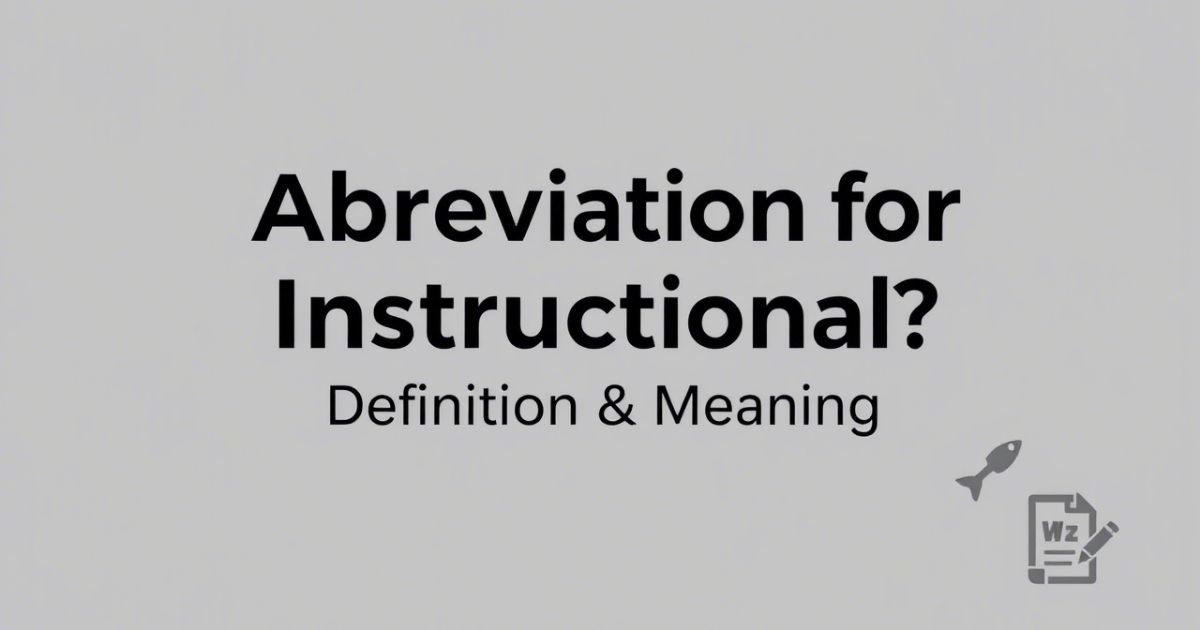Ever seen Instr. or Inst. and wondered what they mean? They’re not just random letters. They’re the abbreviation for instructional, and they show up more than you think. From lesson plans to digital guides, this one word pops up in classrooms, training rooms, and online courses everywhere.
Using the full word “instructional” over and over gets tiring. That’s why the abbreviation for instructional is so useful. It saves time. It looks cleaner. You’ll find it in instructional materials, instructional videos, and even software training guides. Whether you’re a teacher, student, or employee learning new skills, the abbreviation for instructional keeps things short and smart. So next time you spot Instr. or Inst., don’t skip it. That’s your handy abbreviation for instructional, small letters, big meaning.
What Is the Abbreviation for Instructional?
Let’s get right to the point: the abbreviation for instructional is Instr. or Inst.. These abbreviations are widely used in various educational and training materials to keep things short and easy to read. Whether you’re dealing with lesson plans, instructional videos, or course outlines, these shortened forms help simplify the writing process.
The abbreviation for instructional is especially useful in documents where space is limited, like on instructional handouts or quick reference sheets. It’s also handy when writing to colleagues or students in a more casual or technical setting.
For example:
“Please refer to the Instr. guide for more information.”
“The Inst. manual covers all steps for completing the task.”
In more formal documents, like academic papers or professional manuals, it’s better to write out the full word “instructional” to maintain clarity and professionalism.
Using Instr. or Inst. in the right context ensures your writing stays efficient without losing meaning. So next time you spot Instr. or Inst., you’ll know exactly what it means and where to use it! Whether it’s for teaching, training, or writing manuals, these abbreviations are a practical tool.
Understanding the Meaning and Usage of Instructional
The word instructional is an adjective that refers to anything related to teaching, guiding, or providing knowledge. It describes resources or methods designed to help individuals learn or develop skills. Here’s a more detailed definition:
Instructional: Pertaining to instruction, education, or the act of teaching someone to acquire knowledge or skills.
You’ll come across instructional in a variety of settings, such as:
- Educational settings: Referring to materials, methods, or activities used in teaching students.
- Corporate training: Describing training programs, workshops, or guides designed to help employees gain new skills.
- Media: Used to describe content like instructional videos, tutorials, or online courses aimed at teaching or explaining something.
In each of these contexts, instructional materials or content are created to make learning more efficient and effective. Whether in schools, workplaces, or online learning platforms, instructional resources play a crucial role in skill development and education.
What Does Abbreviation for Instructional Mean?

Instructional refers to teaching, guiding, or providing knowledge and skills. It’s an adjective frequently used in education, training, and learning contexts. Anything described as instructional is designed to help someone learn or understand a subject, task, or concept. Here’s a more precise definition:
Instructional: Pertaining to instruction, or intended to provide teaching or education, specially designed to guide someone in learning a particular topic or skill.
You’ll commonly encounter the word instructional in phrases like instructional video, instructional guide, or instructional materials. These are tools created to help people learn something new, whether it’s assembling furniture, solving a math problem, or learning how to use a new software application.
For example:
“The teacher used instructional materials to help the students understand the lesson better.”
“She produced an instructional video to walk through the steps of the project.”
In essence, if something is instructional, its main goal is to help others learn, improve their understanding, or develop new skills. Whether it’s through instructional content in a textbook or an instructional video on YouTube, anything labeled instructional is crafted with the purpose of teaching and guiding others toward a better grasp of a subject or task.
Definition, Pronunciation, and Examples
Definition
The term instructional is an adjective that describes something related to teaching, guiding, or providing knowledge. It refers to materials, methods, or activities that help learners acquire new skills or information. More formally, it is defined as:
Instructional: Pertaining to or designed to provide instruction, education, or information to help individuals enhance their understanding or develop new skills.
In various contexts, the word instructional is used to describe resources or strategies intended to aid learning, whether in formal education, workplace training, or personal development.
Pronunciation
The pronunciation of instructional can be broken down as follows:
Phonetic spelling: /ɪnˈstrʌkʃənəl/
How it sounds: in-STRUK-schuh-nuhl
To pronounce instructions correctly, emphasize the second syllable, “STRUK.” It helps the word sound smooth and clear.
Examples
Here are some examples of how instruction is used in sentences:
- Educational Context: “The teacher provided instructional materials to help students understand the lesson better.”
- Corporate Training: “The company created an instructional guide for onboarding new hires.”
- Media Content: “I watched an instructional video to learn how to fix the leak in the sink.”
- Online Learning: “The instructional website offers courses on graphic design and web development.”
- Workshops and Seminars: “Participants received instructional pamphlets during the seminar to help them with the exercises.”
These examples demonstrate how the word instructional is commonly used in various fields to describe resources that aid in learning or skill development.
How to Pronounce Abbreviation for Instructional
The common abbreviations for instructional, Instr. and Inst., are both easy to pronounce. Here’s how to say them:
Instr.
- Phonetic spelling: /ɪnˈstrʌk/
- How it sounds: in-STRUK
Inst.
- Phonetic spelling: /ɪnˈstʌk/
- How it sounds: in-STUK
For Instr., you emphasize the second syllable (STRUK). For Inst., it’s similar, but the ending sounds more like “stuck” without a clear vowel sound after the “t.”
Both abbreviations are shortened forms of the word instructional, and while they are not commonly used in formal writing, they help make communication more concise in lesson plans, educational content, and instructional guides. Keep in mind that, while Instr. and Inst. are often used informally or in technical documents, you may prefer to write the full word instructional in professional or academic settings.
Other Examples of Instructional and Its Abbreviation in Context
Here are more examples of how the word instructional and its abbreviation Instr. or Inst. are commonly used in different contexts:
1. Classroom Setting (Formal Use):
“The teacher handed out instructional materials that included worksheets, interactive videos, and a quiz.”
This example shows instruction used in an educational setting, where materials are designed to aid learning.
2. Corporate Training (Formal Use):
“Our company rolled out an instructional program for new hires, focusing on communication skills and teamwork.”
Here, instructional refers to a training program aimed at improving employee performance.
3. Quick Notes (Abbreviation):
“Don’t forget to check the Instr. guide for setup instructions.”
Using Instr. helps keep the note concise while still conveying the message clearly.
4. Technical Guide (Abbreviation):
“Watch the Inst. video to learn how to configure the device.”
In this context, Inst. is a shortened form of instructional, used for quick, clear communication.
These examples demonstrate the versatility of instructional and its abbreviations. Whether in formal educational materials or casual workplace guides, understanding when to use the full word or abbreviation is key to effective communication.
Related Guide:
Synonyms & Antonyms for Many VerboMaster – Verbo Master
Short Abbreviation for Instructional
As mentioned earlier, the short abbreviation for instructional is Instr. or Inst. You might be curious about when it’s appropriate to use these shortened forms.
The abbreviation is ideal for situations where space is limited or when a more concise form is needed, such as in notes, outlines, or technical documents. These short forms maintain clarity and speed up communication, especially in contexts where the meaning is easily understood.
For example:
- “Please refer to the Instr. manual for troubleshooting tips.”
- “The Isn’t. the video will show you how to use the new features.”
In these instances, using Instr. or Inst. keeps the information short while still conveying the necessary details. This is particularly useful in environments like corporate training, educational materials, or technical guides, where brevity is key.
So, next time you need to keep things concise, remember that Instr. or Inst. is the way to go!
Acronym for Instructional
While the word “instructional” is commonly abbreviated, it doesn’t have a standard acronym. Typically, acronyms are made from the first letters of multiple words, but “instructional” is a single word. Therefore, you won’t find a common acronym like you might with phrases such as “SEO” for “Search Engine Optimization.”
However, in specific industries like education or corporate training, acronyms related to instructional concepts are frequently used. These terms help simplify communication and ensure clarity in training environments.
For example:
- ID stands for Instructional Design, referring to the process of creating educational materials or courses.
- ILT refers to Instructor-Led Training, which is a traditional training method where an instructor leads the session.
- CBT stands for Computer-Based Training, where learners use computer systems to engage with training materials.
- LMS means Learning Management System, which is a platform for organizing and delivering instructional content.
Though “instructional” itself doesn’t have an acronym, its role is embedded in many widely recognized terms used in education and training. If you’re in the educational field, you’ll likely encounter these acronyms often.
Synonyms for Instructional

If you’re looking for variety in your writing or want to use a different word than instructional, here are some synonyms to consider:
Educational: Ideal when referring to content, tools, or resources designed to help someone learn or acquire knowledge.
Example: “The educational book provided a deeper understanding of the topic.”
Pedagogical: A more formal term, referring to teaching methods or the theory behind education.
Example: “The pedagogical approach helped the students grasp complex concepts.”
Didactic: Often implies an instructional tone, sometimes with a moral or philosophical undertone.
Example: “The didactic nature of the movie made it a great tool for teaching life lessons.”
Training: Commonly used in corporate or professional development contexts where specific skills are taught.
Example: “The company offers a training program to develop leadership skills.”
Teaching: A more general term used for anything related to instruction or imparting knowledge.
Example: “She used various teaching methods to engage her class.”
Instructive: Used for things that provide clear guidance or explanations.
Example: “The instructive article made complex ideas easy to understand.”
By incorporating these synonyms, you can make your writing more engaging and varied while still conveying the concept of teaching or guiding others. Whether it’s for educational content, training programs, or classroom settings, these alternatives can give your writing a fresh perspective.
Antonym for Instructional
Is there an antonym for instructional? While there’s no exact opposite, several terms suggest a lack of teaching, guidance, or learning.
Some possible antonyms include:
- Non-educational: Content that doesn’t offer any educational value.
Example: “The video was non-educational and just for fun.” - Recreational: Focused on enjoyment rather than instruction or skill-building.
Example: “The event was recreational, with no educational component.” - Uninstructive: Failing to provide helpful guidance or teaching.
Example: “The tutorial was uninstructive, leaving many questions unanswered.” - Non-informative: Lacking valuable or relevant information.
Example: “The article was non-informative and didn’t add to my knowledge.”
These antonyms highlight content or activities that do not aim to instruct or provide education. For instance:
“The course was more recreational, offering no instructional benefit.”
“The app’s content was non-informative, without any useful learning tools.”
The History of the Word Abbreviation for Instructional
The abbreviation for “instructional” has evolved over time, particularly in educational and corporate settings. Historically, the term “instructional” referred to anything related to teaching or guiding, and its use grew alongside formalized educational systems. Abbreviations like Instr. or Inst. became common to streamline written communication in lesson plans, educational guides, and training manuals.
In the early 20th century, the demand for efficiency in educational documentation led to the widespread adoption of abbreviations. Teachers and instructional designers began using Instr. to save space in printed materials, especially in the limited space of textbooks, guides, and technical manuals. This practice reflected broader trends in language simplification during this period.
By the 1970s, the growing influence of technology in education and corporate training programs prompted further abbreviation use. With the rise of computers and digital content, educational materials such as software manuals and online training courses embraced the shorthand. This allowed for quicker communication of instructional content, vital in fast-paced environments.
Today, the abbreviation for instructional is ubiquitous across various fields. Whether in traditional education, corporate training, or online learning platforms, abbreviations like Instr. or Inst. ensure that instructional content remains concise and effective, maintaining clarity while facilitating fast-paced, efficient communication.
When to Use the Abbreviation for Instructional

When should you use the abbreviation for instructional? Here’s a quick guide to help you decide:
- Casual Notes and Communication: Abbreviations like instr. and inst. are useful for informal settings, such as jotting down notes, sending quick emails, or texting colleagues. They allow you to communicate more efficiently without sacrificing meaning.
Example: “Please refer to the instr. manual for setup details.” - Educational Settings: In contexts like lesson plans, course syllabi, or instructional guides, where space is often limited, abbreviations help make your writing more concise. Using these short forms ensures that you don’t crowd the page with extra words.
Example: “The isn’t. The video explains all the steps for the assignment.” - Technical and User Manuals: When you’re working on user guides, technical documentation, or instruction sheets, where clarity and brevity are key, abbreviations like instr. and inst. help reduce clutter. These documents often require streamlined language to convey instructions quickly.
Example: “Refer to the inst. manual for further troubleshooting.”
However, instructional is often a formal term, and it’s better to avoid abbreviating it in more professional or formal settings. In essays, research papers, or academic writing, always use the full word to maintain clarity, professionalism, and proper tone. Using the abbreviation in these cases may confuse your readers or diminish the document’s formal nature.
Example of the Word and Abbreviation in Context
Now that we’ve explored the meaning of “instructional,” let’s dive into some examples showing how both the full word and its abbreviations (instr. and inst.) are used across different contexts.
- In the educational field, instructional materials are a staple. These materials are designed to facilitate learning, whether in classrooms or online settings.
Example: “The teacher distributed instructional handouts to guide the students through the lesson on ecosystems.”
Here, the word “instructional” highlights the purpose of the materials, focusing on their role in teaching. - In corporate training, instructional programs are often implemented to onboard new employees or enhance existing skills.
Example: “Our HR department created an instr. guide that helps employees navigate the new software system.”
The abbreviation instr. is effective in this context because it’s concise and fits well in the formal, instructional content. - For media content, instructional materials can be found in videos, books, or tutorials that teach specific skills.
Example: “I watched an insta. video to learn how to install the new printer.”
Using the abbreviation here keeps the sentence short while conveying the instructional nature of the content. - In online learning platforms, instructional content is crucial for providing a structured learning experience.
Example: “The instructional courses on the platform cover everything from coding to digital marketing.”
Here, “instructional” refers to the educational and guiding purpose of the content offered. - Lastly, during workshops, participants often receive instructional guides or handouts to supplement their learning.
Example: “The workshop provided an instr. sheet with step-by-step instructions on project management.”
The abbreviation instr. works well here as it keeps the message succinct, ideal for quick references in a fast-paced environment.
These examples show how the term “instructional” (or its abbreviations) can be used across various professional and educational contexts.
FAQ’s
What is the abbreviation for instructional?
The most common abbreviation for instructional is Instr. or Inst.. These short forms are often used in training and teaching materials.
What is the short form for instruct?
Instruct is often shortened to Instr. in notes or documents. This is closely related to the abbreviation for instructional as well.
What are the abbreviation instructions?
The common short form for instructions is Inst. or Instr.. It’s similar to the abbreviation for instructional used in guides or manuals.
Where is the abbreviation for instructional used?
You’ll find the abbreviation for instructional in lesson plans, training guides, digital content, and instructional materials across classrooms and corporate training.
Why is the abbreviation for instructional important?
Using the abbreviation for instructional saves space and keeps things clear in documents, instructional videos, study notes, and course outlines.
Conclusion
Now you know the abbreviation for instructional. It’s a small shortcut with a big purpose. People use it in schools, offices, and training centers. The most common abbreviation for instructional is Instr.. Some also use Inst.. These short forms appear in lesson plans, handouts, and guides. You’ll also see them in instructional materials, instructional content, and instructional videos. They’re helpful when writing quickly or fitting content in small spaces.
The abbreviation for instructional keeps writing clear and simple. It saves time for teachers, students, and professionals. It works in educational content, training programs, and even user manuals. You might find it in a curriculum, a syllabus, or a technical guide. Whether you’re making instructional content or just reading it, knowing the abbreviation for instructional helps. Use it in notes, worksheets, and digital content. Keep learning, keep writing, and remember, Instr. is your go-to abbreviation for instructional.

Atlas Reid is an experienced administrator with 5 years of expertise in managing operations, streamlining processes, and ensuring efficiency. Skilled in leadership, organization, and problem-solving to drive business success.








